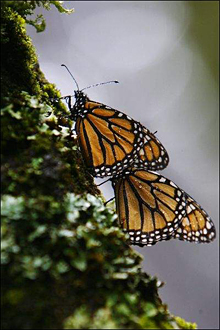
|
 |
 |
 Travel & Outdoors | January 2008 Travel & Outdoors | January 2008  
The Magnificent Monarchs
 Jessica Bernstein-Wax - Associated Press Jessica Bernstein-Wax - Associated Press
go to original


| | A couple of monarch butterflies perch on a tree at the Monarch Butterfly Biosphere Reserve in the central Mexican town of Cerro Prieto. (AP) | | |
If you'd rather see butterflies on a mountaintop than slather yourself with sun block on a tourist-packed beach in Cancun, Mexico is an ideal winter destination.

Ecotourism is drawing fans in the central states of Michoacan and Mexico, thanks to the spectacular yearly migration of millions of orange-and-black-winged monarch butterflies.

In delicate swarms, the butterflies head south from the United States and Canada to Mexico, where they drip from pine trees and coat mountainsides from November to late March. They gather in such astonishing numbers that cars passing the Monarch Butterfly Biosphere Reserve sometimes have to slow to speeds of a couple of miles per hour to avoid splattering the delicate creatures on the windshield as they fly across the road.

"I have on many occasions seen Spaniards, Italians, Americans, Canadians, Mexicans come into the butterfly colonies and literally weep," said Lincoln Brower, a monarch expert at the University of Florida and Sweet Briar College in Sweet Briar, Va.

"It's such an overwhelming emotional experience to realize that you're actually looking at these tens of millions of monarch butterflies that have come into this tiny, little area of Mexico."

The Biosphere Reserve, a federally protected area nominated for World Heritage Site status, spans some 124,000 acres across two states and costs less than $5 to enter and $10 more for a guided tour. In some parts, visitors can trek about on rented horses and burros.

Communal farmers own the land and have the exclusive right to conduct tours. For that reason, many guides don't speak English - so bring a Spanish dictionary if you want to ask questions about the butterflies.

Mexican President Felipe Calderon plans to pump an extra $4.6 million into the reserve's $36.4 million budget this year, to improve infrastructure and make the area more tourist-friendly.

Four butterfly sanctuaries are open to the public on the property: El Rosario and Sierra Chincua in Michoacan, and El Capulin and La Mesa in Mexico state.

Brower, who has studied the flying insects for 52 years, recommends the Michoacan sanctuaries, which he says are among the most popular and offer amenities such as food, souvenirs, and easy access by car. He suggests visitors go in February and March when the butterflies perform an elaborate mating ritual.

"The males chase the females - they zoom around after them and catch them in the air and drop like a dead weight," Brower said. "Then, the male flies off carrying the female, and he'll land up in the trees and mate for several hours."

Astrid Fisch, director of operations for Ecotours de Mexico, an environmentally conscious travel agency based in Puerto Vallarta, said she tells foreign clients to go on weekdays to avoid throngs of Mexican tourists.

Be prepared to hike anywhere from 20 minutes to over an hour or to ride a donkey. You can reach the butterflies only on paths laid by the reserve, and they congregate at extremely high altitudes - between 9,000 and 11,000 feet - so visitors should be in good enough physical condition to handle steep inclines. | 
 | |
 |



